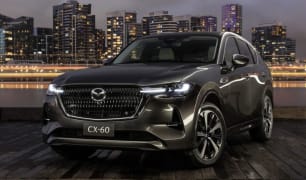The cabin is practical with its great sense of space in both rows, which is not always the case for a mid-sized SUV. Taller families will love how much legroom there is to be had.
The front passenger can get comfortable with the eight-way power adjustments on their seat but the driver enjoys the most perks with 10-way adjustments, lumbar support and two-position memory function.
Both seats have heat function (up to three levels) and are well-cushioned for a longer trip.
The rear seats are well-padded and feature a handy 40/20/40 split-fold for internal storage. The outboard seats also have a heat function for added comfort.
My six-year old found this car to be super easy to get in and out of because of the 175mm ground clearance. He also enjoyed a good view from the wide windows and liked the amenities, like the directional air vents and reading lights.
Individual storage is decent in both rows but the front passengers get the best options with two cupholders, extra-large storage bins in each door, a glove box and a middle console, which is on the shallow side.
Back seaters get two cupholders in the fold-down armrest, small storage bins in each door and a couple of map pockets.
The technology looks upmarket with the dashboard being headlined by two separate 12.3-inch digital screens.
The multimedia system is easy enough to use but I wish Mazda enabled touchscreen access on this as it’s a pain to use the rotary selector dial while on the go.
That said, it’s fab that you get wireless Apple CarPlay and wired Android Auto, plus built-in satellite navigation.
The premium Bose sound system with its 12 speakers makes for a concert-like experience and the charging options are good throughout the car.
Up front you get two of the faster USB-C ports, a 12-volt socket and a wireless charging pad to choose from.
In the back seat you get another two USB-C ports plus a handy 220-volt (150W) port for bigger items. In the boot you get another 220-volt port but this one has 1500W capacity, so larger appliances can be hooked up.
The boot rounds out the cabin practicality with a decent 477L of capacity but you can bump it to 1726L if you fold down the rear seats. There are manual levers in the boot to do this.
The level load space makes it easy to slide things in and out and I always enjoy having a powered tailgate. A flipside to all of this room though is that you only get a tyre puncture repair kit rather than a physical spare.

